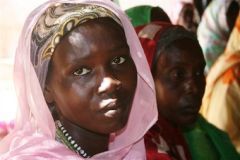Sudan refugees yearn for home but fear future
May 11, 2007 (KIRYANDONGO CAMP, Uganda) — Mark Ochan longs to return to his birthplace in southern Sudan, but fears there could be nothing left to go back to.
 For 16 years, he has lived in a Ugandan refugee camp, growing maize and sending his three children to Ugandan schools. Soon he must leave.
For 16 years, he has lived in a Ugandan refugee camp, growing maize and sending his three children to Ugandan schools. Soon he must leave.
“I feel stranded. I want to go back, but there is nothing left after the war. Why should I go back somewhere with no schools or roads or clinics?” the 42-year-old asked, standing in front of a brick school next to a bright green maize field.
It is a question posed by many of the 170,000 southern Sudanese refugees living in Uganda after fleeing the country’s 20-year conflict.
The war between the Islamist government in Khartoum and the Christian and animist southern rebels killed two million people and displaced twice as many before a 2005 peace deal. But armed clashes and banditry persist in the lawless south.
“Life in the camp is not that bad,” said Ochan, surveying an expanse of neat, cultivated land. “But there, they are still killing. It will be difficult to start again.”
This week, a delegation of Sudanese, Ugandan and U.N. officials visited one of Uganda’s biggest camps for Sudanese refugees in an effort to convince them to go back.
“Life here is ok, but it has to come to an end,” Bhairaja Panday, deputy representative in south Sudan for the United Nations High Commissioner for Refugees (UNHCR), told Reuters. “Asylum can only be a temporary solution. They will have to go to a situation that is (initially) not as good as this one.”
UNHCR says 46,000 Sudanese in Uganda have already been repatriated.
Tens of thousands have also come back from Ethiopia, Kenya and the Central African Republic.
Despite the challenges, most refugees want to go home.
“I have not seen my parents for seven years,” said Michael Lony, who left his family behind in southern Sudan. “As soon as we get facilitation to go back, I am going.”
WARY OF RETURNING
But many are still wary of returning to a region devastated by war, lacking basic infrastructure, where crops have vanished and thatched homes long since crumbled.
Aimed at repairing south Sudan, the 2005 peace pact created a semi-autonomous southern authority, a national coalition government, separate armies and oil wealth sharing, plus the option of full independence in a 2011 referendum.
Simon Kun, Sudan’s commissar for refugees, told Reuters the government would use revenue from the country’s southern oil fields to build infrastructure for returnees.
He added that they would get food aid for the first few months of repatriation. “They must join the traders making money building a new southern Sudan,” he said.
But many still find the prospect of starting from scratch daunting, especially as armed groups, like Uganda’s Lord’s Resistance Army, continue to terrorise civilians.
For others, the war left too many painful memories.
Kiryandongo Camp leader Kevin Lamoo, 36, said she fled south Sudan after Khartoum’s army tortured and killed her husband, accusing him of spying. She was imprisoned and raped.
“They sexually abused me and they kept saying, ‘Why aren’t you circumcised?’ But I am a Christian,” she said.
After a prison guard helped her escape, she was then captured by the rebels and subjected to similar abuse. Most of her family have since been killed. “I have no interest in going back. There is nothing for me there except bad memories.”
Past horrors aside, most south Sudanese say the key to rebuilding their ruined country will be sticking together.
“We have to go back as a group,” said Agnes Lakot, a teacher. “We built a life from nothing in Uganda, we can go back together to build something new in Sudan.”
(Reuters)
